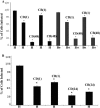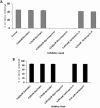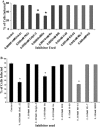Interaction of Cryptosporidium hominis and Cryptosporidium parvum with primary human and bovine intestinal cells
- PMID: 16368962
- PMCID: PMC1346631
- DOI: 10.1128/IAI.74.1.99-107.2006
Interaction of Cryptosporidium hominis and Cryptosporidium parvum with primary human and bovine intestinal cells
Abstract
Cryptosporidiosis in humans is caused by the zoonotic pathogen Cryptosporidium parvum and the anthroponotic pathogen Cryptosporidium hominis. To what extent the recently recognized C. hominis species differs from C. parvum is unknown. In this study we compared the mechanisms of C. parvum and C. hominis invasion using a primary cell model of infection. Cultured primary bovine and human epithelial intestinal cells were infected with C. parvum or C. hominis. The effects of the carbohydrate lectin galactose-N-acetylgalactosamine (Gal/GalNAc) and inhibitors of cytoskeletal function and signal transduction mechanisms on entry of the parasites into host cells were tested. HCT-8 cells (human ileocecal adenocarcinoma cells) were used for the purpose of comparison. Pretreatment of parasites with Gal/GalNAc inhibited entry of C. parvum into HCT-8 cells and primary bovine cells but had no effect on entry of either C. parvum or C. hominis into primary human cells or on entry of C. hominis into HCT-8 cells. Both Cryptosporidium species entered primary cells by a protein kinase C (PKC)- and actin-dependent mechanism. Staurosporine, in particular, attenuated infection, likely through a combination of PKC inhibition and induction of apoptosis. Diversity in the mechanisms used by Cryptosporidium species to infect cells of different origins has important implications for understanding the relevance of in vitro studies of Cryptosporidium pathogenesis.
Figures







References
-
- Abrahamsen, M. S., T. J. Templeton, S. Enomoto, J. E. Abrahante, G. Zhu, C. A. Lancto, M. Deng, C. Liu, G. Widmer, S. Tzipori, G. A. Buck, P. Xu, A. T. Bankier, P. H. Dear, B. A. Konfortov, H. F. Spriggs, L. Iyer, V. Anantharaman, L. Aravind, and V. Kapur. 2004. Complete genome sequence of the apicomplexan, Cryptosporidium parvum. Science 304:441-445. - PubMed
-
- Buret, A. G., A. C. Chin, and K. G. Scott. 2003. Infection of human and bovine epithelial cells with Cryptosporidium andersoni induces apoptosis and disrupts tight junctional ZO-1: effects of epidermal growth factor. Int. J. Parasitol. 33:1363-1371. - PubMed
-
- Chen, M. L., C. Pothoulakis, and J. T. LaMont. 2002. Protein kinase C signaling regulates ZO-1 translocation and increased paracellular flux of T84 colonocytes exposed to Clostridium difficile toxin A. J. Biol. Chem. 277:4247-4254. - PubMed
-
- Chen, X. M., B. Q. Huang, P. L. Splinter, H. Cao, G. Zhu, M. A. McNiven, and N. F. LaRusso. 2003. Cryptosporidium parvum invasion of biliary epithelia requires host cell tyrosine phosphorylation of cortactin via c-Src. Gastroenterology 125:216-228. - PubMed
Publication types
MeSH terms
Grants and funding
LinkOut - more resources
Full Text Sources
Medical

